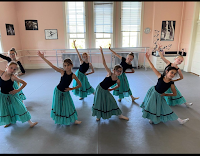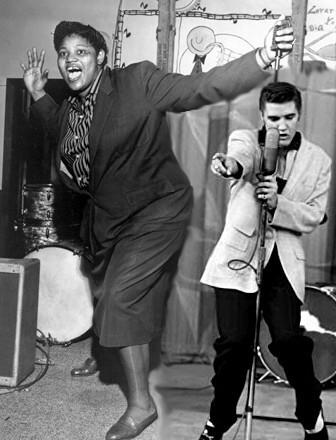 |
I like the way character dance combines the control and elegance of ballet with more unrestrained and exuberant kinds of movement, and I enjoy getting into “character” as well. I think it’s good for the kids to experiment with a slightly different dance form that gives them space to inhabit a different kind of persona, ham it up a bit, and have fun.
But there’s a little problem. Character is based on the movements of traditional dance forms often practiced by the lower classes at the same time that classical ballet was taking shape as an art form associated with the elite. In other words, it’s a balletified version of “folk dance.” As RAD students, we learned that it’s called “character dance” not because it helps you get into a character in the dramatic sense of a distinct persona, but rather because it relates to the “national character” it represents: the fiery Spaniard, the hectic Neapolitan, the haughty and impulsive Hungarian, and so on down the increasingly uncomfortably essentializing, culturally snobbish, and nationalistic road.
And indeed, character dance variations began to appear in ballets during the second quarter of the nineteenth century, a product of Romanticism and nationalism. For audiences and impresarios of the time, ballet was European, and belonged to the courtly and cosmopolitan elites. Folk dance was associated with “low” types: peasants and the urban poor, people who were thought (by the elite) to represent the wild strain of whatever ethnicity or nationality. Thus, elements of folk dance, incorporated into the balletic movement vocabulary allowed choreographers to enhance their storytelling – the mazurka in Act I of Coppélia situates the ballet in Poland. By the time you get to the late nineteenth century, character variations were almost de rigeur: Swan Lake, The Nutcracker, Don Quixote, they all use character dance to enrich the narrative and break up the monotony.
Anyone who has ever seen The Nutcracker in particular can appreciate how character becomes, in itself, a goal – a huge chunk of Act II is just one darn character dance after another, each one designated in the original libretto by a type of sweet or treat that like the stylized “folk” dance of the movement has an iconic relationship to a particular nationality: chocolate from Spain, coffee from Arabia, tea from China, candy canes (!) from Russia, mirliton cakes from France. And this is hugely problematic, as many recent critics from within and outside of the ballet world have pointed out. Most glaringly, the dances representing Arabia and China trade in orientalist cliches about the exotic east and racist and sexist stereotypes about “the Orient” that were deeply woven into the culture of European imperialism by the time Tchaikovsky and his collaborators came along. Until quite recently (and in some cases still) ballet companies have blithely put white dancers in yellowface and brownface for these roles, trading on the worst racial stereotypes imaginable, or they have only cast their Asian and Black or Brown dancers in these roles, reserving the starring parts for white people.
Therein lies the problem: at its foundation, character dance was an act of cultural appropriation, defined as “The unacknowledged or inappropriate adoption of the customs, practices, ideas, etc. of one people or society by members of another and typically more dominant people or society.” The cultures being appropriated were often those of Europe – but the poorer, less cosmopolitan, less privileged segments of European society in the nineteenth century. Peasants in the burgeoning nation-states of nineteenth-century western Europe lived in a manner that their medieval forebears would not have found entirely alien, far more so than their wealthy countrymen. The life of the urban poor described in the novels, for example, of Dickens or Zola, or in the lithographs of Honoré Daumier was also a pretty far cry from “modern” and “comfortable.” So when the dance forms endemic to those populations were borrowed, gussied up, and performed on stages to audiences of the privileged, it was a form of theft and erasure no less than when white musicians in the mid-twentieth century adopted the musical style of Black American blues and gospel and performed them for all-white audiences (often in clubs that excluded the presences of Black bodies except in servile roles).
Which is complicated, right? Because even if cultural appropriation was happening, art was also happening, and it can be incredibly hard to disentangle the bad faith and crappy ethics and thoughtless plunder from the aesthetic or sensual or intellectual merits of the thing being created. To put it another way, Elvis was clearly engaging in cultural appropriation, even if what he thought he was doing was honoring the musical traditions he had grown up admiring, but he was also making some pretty great art himself. I mean, you can’t listen to him growling his way through Big Mama Thornton’s “Hound Dog,” and remain unmoved. I mean, maybe you can, but you’re missing something, in that case. Likewise, I defy anyone – and by anyone, I mean not just the typical balletomane, but anybody with eyes and ears that work, to watch a good performance of the Trepak (aka Russian or Candy Cane) variation in a well-crafted Nutcracker and not be stirred. That’s just exuberance, made manifest.
But it is also a Trepak, which is a very old dance of the Cossacks, a semi-nomadic minority group indigenous to the region of eastern Ukraine even now under assault by the resurgent Russian empire. At the time of The Nutcracker’s creation, the Cossack homelands were firmly under Russian control, and the people themselves were subjects of the Tsar. Ethnic Russians viewed them warily, and understood them as exotic outsiders, definitely not European, but part of the empire’s Asiatic heritage (the Cossacks are of Turkic origin). Cossacks were associated with violence and barbarism (not without reason, since their arrangement with the Russian state required military service by the men), but also with a kind of wild, ecstatic dance that was half martial art. Those deep plies, split jumps, and squat-kicks are great for building the kind of thigh muscles you need to control a horse at full gallop with your legs alone, leaving your hands free to wield your weapons.
[Fun fact: Rudolf Nureyev was Tatar Muslim (not Cossack), another minority group from the Black Sea region of the Soviet Union, but he studied Cossack dance as a child and liked to dress up as a Cossack, since that was a more glamorous thing to be than Tatar, apparently.]
Phil Chan and Georgina Pazcoguin, the founders of Final Bow for Yellowface, have spent the last half decade as activists from inside the world of professional ballet working to change the way the art form represents Asia and Asians. They point out that for audience members, board members, dancers at all stages of their training, and families of dancers, narrow, racist, and colonialist depictions of Asians on stage are deeply alienating. That said, their goal is not to eliminate things like the “Tea” variation from The Nutcracker. Rather, as they say, “It’s time to replace caricature with character.”
As we head into Nutcracker season, I hope that we’re all watching out for the ways in which character dance can be deployed with sensitivity and grace, with respect for the history of the art form as well as for the living human beings who inhabit it and who come to theaters as audience members, and with awareness of the troubled and complex history of Eurocentrism, nationalism, class oppression, and colonialism that is bound up in the history of ballet. This isn't about "cancelling" it's about evolving; if you have access, do read Jennifer Fisher's excellent essay in the Los Angeles Times on this subject. And she literally wrote the book on the Nutcracker in North America (Nutcracker Nation, Yale University Press, 2004).
And in the meantime, I will be thinking about how I talk about the character styles I’ll be teaching my students in my fall workshop. They’re kids, so I don’t want to get too heavy, but at the same time, they are developing artists, and I want them to really understand the art form in which they are training. I am pretty sure that thanks to the people who are leading the charge to rethink ballet’s problematic history with race and class are saving ballet for the future, and I want to be part of that.




No comments:
Post a Comment